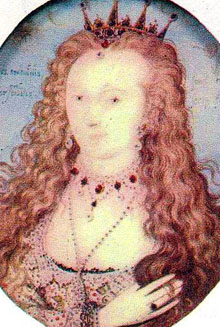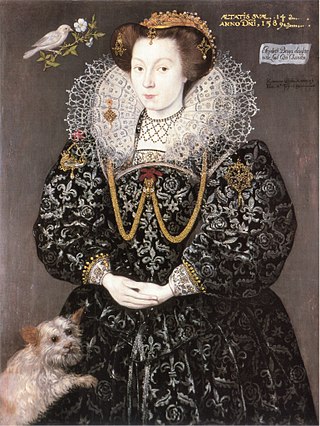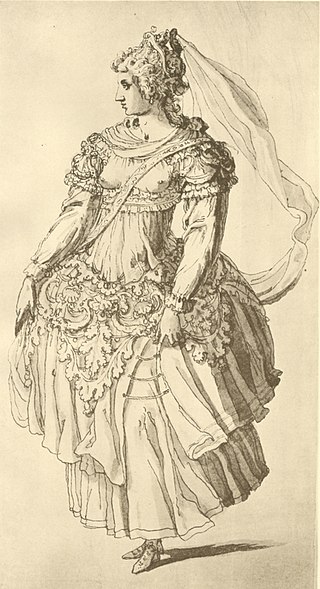George Hastings, 4th Earl of Huntingdon was an English nobleman.
The Entertainment at Althorp, or The Althorp Entertainment, performed on 25 June 1603 is an early Jacobean era literary work, written by Ben Jonson. It is also known as A Particular Entertainment of the Queen and Prince, or The Satyr. The work marked a major development in Jonson's career, as the first of many entertainments and masques that he would write for the Stuart Court.

Henry Hastings, 5th Earl of Huntingdon, was a prominent English nobleman and literary patron in England during the first half of the seventeenth century.

Elizabeth Hastings, Countess of Huntingdon, formerly Lady Elizabeth Stanley, was an English noblewoman and writer who was third in line of succession to the English throne. She was the wife of Henry Hastings, 5th Earl of Huntingdon. She was also styled Lady Hastings of Hungerford and Lady Botreaux as her husband held both of these titles in addition to the Earl of Huntingdon.

Alice Spencer, Countess of Derby was an English noblewoman from the Spencer family and noted patron of the arts. Poet Edmund Spenser represented her as "Amaryllis" in his eclogue Colin Clouts Come Home Againe (1595) and dedicated his poem The Teares of the Muses (1591) to her.

Susan Herbert, Countess of Montgomery, was an English court office holder. She served as lady-in-waiting to the queen consort of England and Scotland, Anne of Denmark. She was the youngest daughter of Elizabethan courtier, and poet Edward de Vere, 17th Earl of Oxford.
Lady Audrey Walsingham was an English courtier. She served as Lady of the Bedchamber to queen Elizabeth I of England, and then as Mistress of the Robes to Anne of Denmark from 1603 until 1619.

Elizabeth Brydges was a courtier and aristocrat, Maid of Honour to Elizabeth I, and victim of bigamy. She was a daughter of Giles Brydges, 3rd Baron Chandos, and Frances Clinton, who lived at Sudeley Castle.

Tethys' Festival was a masque produced on 5 June 1610 to celebrate the investiture of Prince Henry (1594–1612) as Prince of Wales.
Dorothy Hastings was a courtier to Elizabeth I of England and Anne of Denmark
The Harefield Entertainment included hospitality and performances for Elizabeth I of England in August 1602. Several copies of the performance script survive, probably written by John Davies, along with the original manuscript accounts of the Queen's host which seems to have been manipulated by literary forgery in the 19th-century to enhance their interest.

Sir Thomas Griffin was an English landowner and hosted the royal family at Dingley.

Prince Henry's Welcome at Winchester was a masque produced by Anne of Denmark and performed in 1603 at Winchester on a day between 11 and 17 October.
Philadelphia, Lady Scrope was an English aristocrat and courtier.

Anne St John was an English aristocrat and courtier.

Anne Keilway, Lady Harington was an English courtier.

The wedding of Elizabeth Stuart (1596–1662), daughter of James VI and I, and Frederick V of the Palatinate (1596–1632) was celebrated in London in February 1613. There were fireworks, masques, tournaments, and a mock-sea battle or naumachia. Preparations involved the construction of a "Marriage room", a hall adjacent to the 1607 Banqueting House at Whitehall Palace. The events were described in various contemporary pamphlets and letters.
The Entertainment of the Two Kings of Great Britain and Denmark or The Hours was written by Ben Jonson and performed at Theobalds House on 24 July 1606. John Harington of Kelston described another masque of Solomon and Sheba, performed one day at Theobalds after dinner. There is some doubt over Harington's account. In May 1607 another masque An Entertainment of the King James and Queen Anne at Theobalds was performed when the keys of the house were given to Anne of Denmark.

The Masque of Owls at Kenilworth was written by Ben Jonson and performed at Kenilworth Castle on 19 August 1624 for Prince Charles.
Frances Knyvet or Knyvett (1583–1605) was an English courtier who performed in masques.












